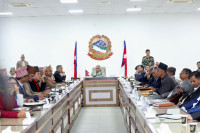National
Health officials fear leprosy resurgence in the country
The prevalence rate of leprosy, which was declared eliminated in 2009, reached 0.94 percent in 2018, which experts fear marks the resurgence of the disease in Nepal. The percentage could be more, officials say, as the current said percentage has been derived just from preliminary data.
Arjun Poudel
The prevalence rate of leprosy, which was declared eliminated in 2009, reached 0.94 percent in 2018, which experts fear marks the resurgence of the disease in Nepal. The percentage could be more, officials say, as the current said percentage has been derived just from preliminary data.
Health officials fear that the country could lose its ‘elimination status’ of leprosy, as it is seeing a significant increase in the number of leprosy patients in recent years. The country stands to lose this status if the prevalence rate reaches one percent of the total population.
The country had received the leprosy eliminated status, after reducing its prevalence rate by 0.77 percent, in 2009. The Leprosy Control and Disability section of Epidemiology and Disease Control Division of Department of Health Services said that the prevalence rate was 0.92 and 0.89 in 2017 and 2016 respectively.
“It will be a great setback for the country if it loses the status,” said Dr Rabindra Baskota, chief of the section. “It will take only a couple of years to reach one percent if this upward trend continues.” He informed that the prevalence rate is over one percent in various districts of the Tarai region.
Leprosy, a chronic infectious disease caused by Mycobacterium leprae, is transmitted through nasal secretion or from droplets from the mouth. It affects the skin, peripheral nerves and eyes, leading to disfigurement and nerve damage. The disease is curable with a multi-drug therapy.
Dr Baskota, however, said that this detection of more leprosy patients should not be taken negatively, as it helps provide timely treatment to patients and also brings cases that have remained hidden so far to the fore. Incubation period of leprosy varies from 1 to 20 years and diagnosis of more patients could help stop the further spread of the disease, according to him.
“We must not neglect this once-neglected disease,” he said, adding that effective measures of intervention are needed to reduce the disease burden.
Sishir Silwal, a focal person for the leprosy control programme serving in Gulmi district, said that regular review meetings for leprosy, which should be held every four months, has not been held for the last eight months. “The reporting system to the centre has been disturbed and the focal persons have been demanding medicines based on the previous year’s demand,” informed Silwal.
Dr Bibek Kumar Lal, Director at EDCD, concedes that his division has not been able to give much priority to the programme, blaming severe manpower crunch. “Earlier there was a separate division to take care of the programme, but now it’s under our jurisdiction and we don’t have enough people to work for the programme effectively,” said Dr Lal, adding that only three staff have been working in the leprosy section. The same team also looks after the disability programme.




 15.12°C Kathmandu
15.12°C Kathmandu




.jpg&w=200&height=120)










